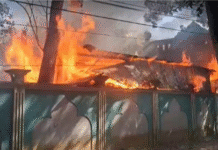Shahid Islam
Compromising on national security is no less disgusting, harmful and dangerous than allowing one’s spouse to flirt with a common friend of opposite sex. The ultimate outcome in both the instances is tearful eyes and fearful lives.
Nightmares still revisit when Bangladeshis are reminded of the 1972 Treaty of Friendship with India, and, despite the elapse of that 25 year treaty in 1997, Bangladesh-India defence cooperation has been excellent; thanks to the AL-led regime’s bolder moves to handover Indian rebel leaders to Delhi; blank approval of transit facilities to Indian heavy vehicles through Bangladesh against assessed incapability of Bangladesh’s road infrastructure; as well as allowing of over 20 major Indian corporations and business entities to market Indian products inside Bangladesh without facing reasonable restrictions.
Candy for toddler
Besides, allowing dozens of Indian electronic media to poison the mindset and adversely proselytize our people inside every Bangladeshi bed and living room, while none of the Bangladeshi channels could have entry inside India due to heavy premiums imposed, is a decision went sour and awry with our custom and tradition. People are resentful of such cultural aggressions.
As people and voter don’t matter anymore, Dhaka has given, and still giving, anything Delhi asks for. What Delhi gave in return is not reckoned, which is as insignificant as the mother’s doling of a candy to a crying toddler. Indian export to Bangladesh already hitting US$7 billion mark in recent years, export of Bangladeshi goods to India remains blocked by a variety of tariff and non-tariff barriers, enabling Dhaka only to export goods worth about $395 million at the most.
Besides, mutual water sharing treaties, especially the Tista treaty, are being delayed by Delhi on many excuses while killings at the border by Indian forces remain harrowingly alive and hardly reduced. If Bangladesh had exported goods worth about $39.71 billion from July 2015 to June 2016, what percentage of it went to India is a question that boggles the mind of every Bangladeshi citizen. But Delhi hardly cares, and Dhaka always sucks up in muddle-up.
The proposed defence cooperation pact with Bangladesh is the latest in India’s wish-list, but not the last; following Dhaka conceding over the years to grant transit to India through Akhaura-Agartala, Khulna-Kolkata, and to the Bangladeshi ports of Ashugonj, Mongla and Chittagong; the latter via a bridge being constructed near Feni to connect southern Tripura of India. The Feni-Chittagong axis stretches to Myanmar and, is globally renowned as a theatre of major wars; on which Allied forces too fought with the Japanese during the Second World War.
Credit touted as investment
That Delhi had always treated Dhaka as a baby is no secret, perhaps due to the nanny role it played in the creation of Bangladesh in 1971, and the AL is the party that did and does anything for India, often at the cost of national interest. Since 2009, India had injected over $3 billion worth of credit in different projects of its liking inside Bangladesh and, is mulling the infusion of another $11 billion by 2018. Simply put, the projects being pursued with Bangladesh by India are designed to help India overcome its geopolitical and economic handicaps. None of them can be likened to the typical FDI that Bangladesh and other nations get from international investments.
For instance, to allow heavy Indian vehicles to ply through Bangladesh to the Indian northeast, a promise has been made to loan $750 million. A study of about 12 such proposals made by Delhi from 2009-2016 shows the government of India, as well as its corporations, are willing to tie up Bangladesh with billions of dollars of loans and credits, which, under international investment laws, could hurt Bangladesh’s credit ratings at a time when it wishes to climb above the under-developed threshold by 2021; unbeknownst that one of the major yardsticks to assess a country’s economic status is to measure its debt-GDP ratio.
Another typical example is: in 2014, Delhi extended a $1 billion soft loan for infrastructure development and another $1 billion for the Padma Bridge, of which $862 million was preconditioned to buying equipment and services from Indian companies.
Energy loops
Another major Indian foray inside the Bangladesh economy has been in the field of energy cooperation, especially to build coal-based power plant within 14 miles radius of a global heritage site in Khulna; something Delhi failed to implement within its own country due to court-imposed restrictions. Credit is also given to projects that will export electricity to Bangladesh from its north-eastern region while Bangladesh’s request to have access to Nepal’s and Bhutan’s power through India dangles for years in a limbo.
In hindsight, it was unwise and anti-national for Dhaka to allow India to transfer hydroelectricity from Assam to Bihar through Bangladesh territory while Dhaka’s proposal for an integrated regional ‘power corridor’ was not entertained by Delhi with equal sincerity and reciprocity.
Dubious defence pact
Now Delhi wants a comprehensive defence cooperation agreement despite the two countries already having excellent cooperation in the field. Since 2009, India has been holding direct Army-to-Army staff talks with Bangladesh; something it usually does with the US, UK, Israel, France, Japan, Australia, Malaysia, Indonesia and Singapore. The two forces also hold a routine joint exercise codenamed ‘sampriti’; the sixth run of which took place lately in Tangail.
These war games are a mockery. For, in so far as defence collaborations are concerned, India belongs to the broader western alliance; not Asia where China, Russia, Iran, Pakistan and Turkey want to reduce aggressive western hegemony and military interventions. Bangladesh’s existing foreign policy also runs contrary to signing such a pact with India.
Yet, in November 2016, Delhi dispatched its defence minister, Manohar Parrikar, to Dhaka with a draft copy of the proposed pact which Dhaka studied with hushed resolve and sweating composure. Then came the delivery of the two Chinese submarines and the Indian expressed concerns over Bangladesh strengthening its armed forces in number and capabilities.
Let’s warn that, Delhi’s latest attempt to have Dhaka sign a comprehensive, 25-year agreement on defence cooperation is based on similar geopolitical and economic considerations which are always against the sovereign interest of Bangladesh. Delhi wants Dhaka to take a loan of $ 500 million and buy Indian-arms and electronic gadgets, commit to undergo an interoperability regime of the two armed forces, and consider an attack on each as the one on the other too. Does that mean Bangladesh will fight China if India and China start shooting each other? No way.
Instead, $500 million could be better spent on paving Bangladesh’s river banks to save people from river erosions, given that the defence cooperation, as it is, already entails much better recipes to keep Bangladesh equidistant from Beijing, Delhi and Washington to facilitate its move toward ridding the nation of extreme poverty and becoming a developed nation sooner than expected.
Lesson from Sri Lanka
Time is also ripe to assess India’s policy patterns with microscopic precision. A major problem with India is its proven reluctance to investing in any Muslim predominant country, although its desire to use that country as a market is quite visible. Inside Bangladesh, over 80 per cent of heavy vehicles, and over 70 per cent of smaller three-wheelers, are imported from India by a business cabal that also leads the country’s business organizations and outfits. Yet, Indian companies are not willing to invest inside Bangladesh in joint ventures to produce such vehicles, which could employ thousands of Bangladeshi workers. Curiously, Indian companies are willing to extend credits for handpicked projects suiting their customized needs.
Sri Lanka tried in 2013 to fend off one of such Indian forays in dumping low quality automobiles into its market by India and stopped the nuisance by imposing increased import duty from 120-291% to 200-350% on cars; from 51-61% to 100% on three-wheelers; and from 61% to 100% on scooters and motorcycles; besides clamping huge excise duty on import of all automobiles. Resultantly, during April-December 2013, India’s automobile exports to Sri Lanka dropped to $357 million from $1 billion in 2011-12. This led to aggressive marketing of Indian automakers inside Bangladesh.
Death of local industries
Another ignored fact is that: over 90 per cent of road collusions occurring in Bangladesh—on an average six per day, with dozens of deaths and injuries—are caused by Indian-made vehicles. This is something Bangladeshi policy makers must look into soon.
Above all, Bangladesh’s budding local industries are facing intensive competition due to market penetration by Indian Reliance Industries, the Tata Group, Ashok Leyland, Hero MotoCorp, Airtel, Marico, Godrej, VIP Industries, Ceat Tyres, Ambattur Clothing, Sahara, Liamp, and others. It’s painful to see local TV ads inside Bangladesh gleefully sporting Indian product advertisements, including of TATA tea, as if Bangladeshis have been tea- thirsty for ages. Our local tea industries will die sooner if this trend is not trapped, draped and chucked out of our national frontier.
The very fact that PM Sheikh Hasina’s proposed visit to Delhi had to be postponed twice since December 2016 has much to do with what the Bangladesh armed forces want her do with respect to signing any military deal with India. Sources say the draft deal with India collides with a comprehensive defence collaboration agreement Dhaka had inked with Beijing.
Although none knows precisely what that pact entails, Bangladesh had depended on China for over 80 per cent of its military hardware needs since the mid-1970s. Besides, China and Bangladesh signed an unprecedented development financing deals worth US$25 billion during President Xi Jinping’s visit to Dhaka in November 2016. This huge investment alone will raise the country’s GDP by 3 per cent when implemented. From that context, it’s time to assess and decide whether the nation’s future is more tied up with Delhi, or Beijing. Both are our tested friends and shall remain so. But no defence pact, please.
Source: Weekly Holiday









